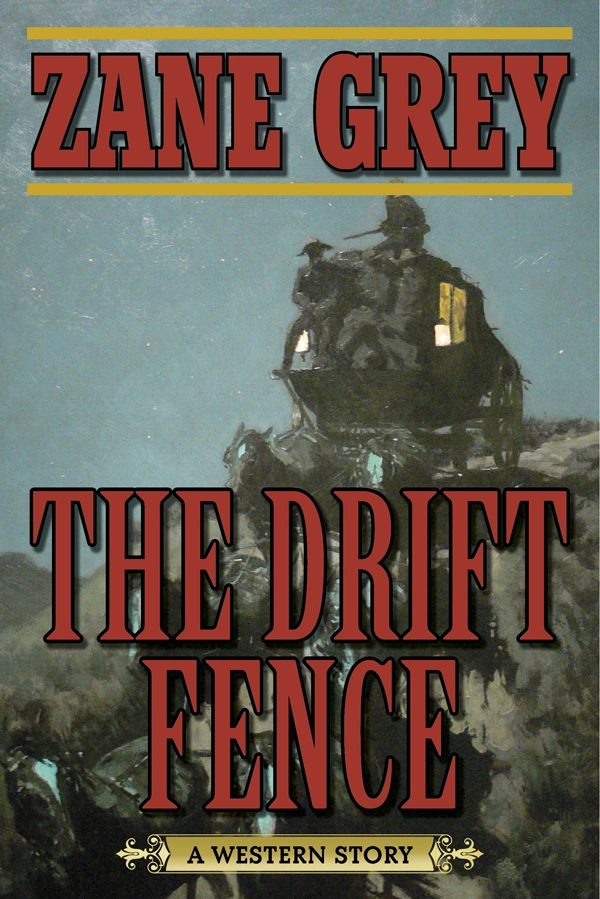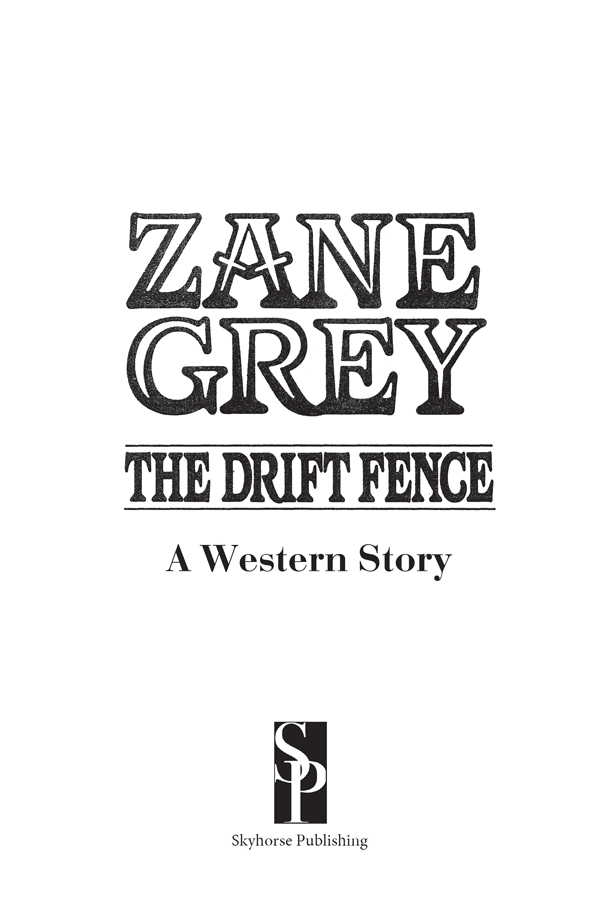The Drift Fence


First Skyhorse Publishing edition 2016 by arrangement with Golden West
Literary Agency
Copyright © 1929 by Zane Grey
Foreword © 2016 by Joseph Wheeler, PhD
All rights reserved. No part of this book may be reproduced in any manner without the express written consent of the publisher, except in the case of brief excerpts in critical reviews or articles. All inquiries should be addressed to Skyhorse Publishing, 307 West 36th Street, 11th Floor, New York, NY 10018.
Skyhorse Publishing books may be purchased in bulk at special discounts for sales promotion, corporate gifts, fund-raising, or educational purposes. Special editions can also be created to specifications. For details, contact the Special Sales Department, Skyhorse Publishing, 307 West 36th Street, 11th Floor, New York, NY 10018 or [email protected].
Skyhorse® and Skyhorse Publishing® are registered trademarks of Skyhorse Publishing, Inc.®, a Delaware corporation.
Visit our website at www.skyhorsepublishing.com.
10 9 8 7 6 5 4 3 2 1
Library of Congress Cataloging-in-Publication Data is available on file.
Cover design by Brian Peterson
Print ISBN: 978-1-63450-814-8
Ebook ISBN: 978-1-63450-076-0
Printed in the United States of America
Contents
Introduction
Chapter 1
Chapter 2
Chapter 3
Chapter 4
Chapter 5
Chapter 6
Chapter 7
Chapter 8
Chapter 9
Chapter 10
Chapter 11
Chapter 12
Chapter 13
Chapter 14
Chapter 15
Chapter 16
Chapter 17
Chapter 18
Chapter 19
Chapter 20
Chapter 21
Chapter 22
Chapter 23
About the Author
INTRODUCTION
THE TENDERFOOT WHO MAKES GOOD AND THE GIRL WHO LONGS FOR MORE
Only a writer who actually lived in the West while it was still “wild” could have written The Drift Fence, thus allowing the word “authentic” to be validly stamped on every page.
It was late summer of 1928, and Grey was fishing from Fisherman, his white-winged yacht, off the island of Tahiti. For some time he’d been thinking about his next book; not easy, for the just-written Arizona Ames was a tough book to follow.
As with all great artistic inspiration, it came to him like a bolt of lightning. During his years of living part-time in his cabin on Arizona’s Mogollon Rim, and interacting with the men, women, and children in this still frontier country, Grey had come to know and empathize with the wild cowboys and the hard-working women who peopled the then Arizona Territory.
Writing about new arrivals to the West was easy because Grey, during his lion-lassoing expedition of 1907-8, had been treated as a tenderfoot himself, when every practical joke cowboys had ever heard of were inflicted on him (this is referenced in Grey’s Last of the Plainsmen). Twenty years later, those practical jokes morphed from real life into fiction: Grey gave the name of Jim Traft to the tenderfoot protagonist who lived through all the torments he’d been forced to endure.
As for the heroine, spunky little Molly Dunn, the lovely sixteen-year-old wood mouse, she too was taken from real life. Grey attended the few public functions held in the Tonto region of Arizona, even the infrequent dances, where liquor, jealousy, courting, and violence were the norm. It was a mighty tough life—especially hard on women, who married young and grew old before their time. Grey’s heart went out to them, and he concluded that he’d model his female protagonist off of them. Additionally, I urge you to pay particular attention to the vernacular when you read this book. Grey did his best to preserve in his novels the actual speech-patterns of his characters.
For anyone today who pigeon-holes Grey’s western novels as little more than shoot-’em-ups, all it would take to disabuse them of this perception would be to read the opening paragraph of this book:
Molly Dunn sat waiting on the rickety old porch of Enoch Summers’ store in the village of West Fork. For once she was oblivious to the approach of the lean-faced, long-legged young backwoodsmen who lounged there with their elders. Molly was sixteen and on the eve of a great adventure. She had been invited to ride to Flagerstown [Flagstaff] with the Sees. She had been there once some years before and the memory had haunted her. In her pocket she had money to buy new stockings and shoes, which compensated somewhat for the fact that she carefully kept her feet and ankles hidden under the bench. She wore her good dress and bonnet, and though not satisfied with them she was not ashamed.
Even today, who could imagine a writer who’d dare to begin a western novel with such a picture of abject poverty—and with a girl at that! But Grey knew his audience, for the greatest family magazines in history serialized his novels—magazines that included American, Good Housekeeping, Ladies’ Home Journal, McClure’s, Cosmopolitan, McCall’s, Pictorial Review, and (ironically), Country Gentlemen.
In Grey’s day, rural Arizona was still locked in isolation, as was true of much of the Southwest. It was a world so inaccessible that it would be an event of the foremost magnitude for a sixteen-year-old girl to ride in a horse-drawn buckboard eighty miles (a two-day’s journey) to shop in the nearest town large enough to stock merchandise. In comparison to today, there was also no mass media—hence an almost double-isolation.
Creations like Molly Dunn are the real reason that there were—and remain today—at least as many female readers of Grey’s novels as there are male readers. It was the genius of Grey that, just by observing and asking questions, he was able to delve so deeply into the hearts and aspirations of the mountain girls all too rapidly forced into adulthood.
Molly is arguably one of Grey’s greatest creations. The pivotal journey of the book her eighty-mile horse-and-buggy ride from the Tonto to then wide-open Flagstaff, where almost all men carry guns. When Molly reaches Flagstaff, a new and fascinating world opens up to her; by the time she returns home, she can never again be fully satisfied with the primitive life she grew up in. Now she longs for more. And it is here in Flagstaff that Molly and Traft first set eyes on each other.
Grey wrote by pencil from 5 to 7 a.m. each morning, before going out to fish. But in his mind, he was back in his beloved Arizona. Thanks to his diaries (which he faithfully kept up), he could travel back in time to the settings in which he would, over time, place a host of characters good and bad, in so many books that would later be treasured by so many millions of readers. Once begun, Grey couldn’t stay away from his story—thus he completed it in only fifty-seven days.
It is safe to say that in no other book Grey ever wrote did he create as full a picture of the American cowboy as he did in The Drift Fence.
1 comment